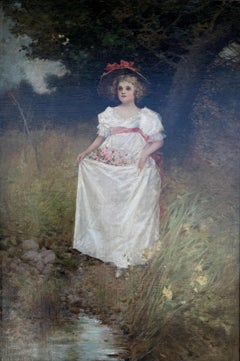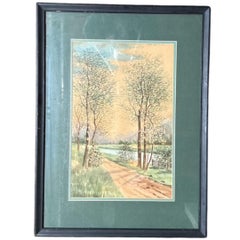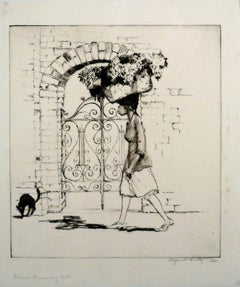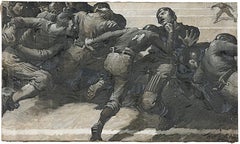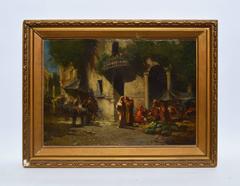Edward Percy Moran Art
to
1
1
Overall Width
to
Overall Height
to
2
2
1
1
1
1
1
1
1
1
1
1
1
2
9,138
2,694
1,352
1,343
2
2
Artist: Edward Percy Moran
"Portrait of a Woman" Edward Percy Moran, Early American Portrait, Bucolic
By Edward Percy Moran
Located in New York, NY
Edward Percy Moran
Portrait of a Woman
Signed lower right
Oil on canvas
30 x 20 inches
Provenance:
The Madison Gallery, Atlanta
Percy Moran was the son of marine painter Edward Mo...
Category
1890s Academic Edward Percy Moran Art
Materials
Canvas, Oil
The Old Mill
By Edward Percy Moran
Located in Jacksonville, FL
This fine engraving titled Washington and His Mother depicts a touching domestic scene between General George Washington and his mother, Mary Ball Washington. Originally created by E...
Category
1890s American Realist Edward Percy Moran Art
Materials
Engraving
Related Items
PHOEBE PASSES MY GATE
Located in Portland, ME
Hutty, Alfred. PHOEBE PASSES MY GATE.
Drypoint, c. 1931. Edition size c.75.
8 1/8 x 7 1/4 inches (plate), 10 1/4 x 8 3/4 inches (sheet).
Print...
Category
1930s American Realist Edward Percy Moran Art
Materials
Drypoint
Old Time Football in the 1920s - Football 1920s - Classic Football
By Walt Louderback
Located in Miami, FL
You Got to be a Football Hero to Get Along with a Beautiful Girl. Masterfully composed and dynamic illustration that show a player getting punched in the jaw. During this period, there were no face...
Category
1920s Academic Edward Percy Moran Art
Materials
Canvas, Oil
$10,000
H 18.8 in W 32 in
"End of Day" Original Limited Edition Etching
Located in Soquel, CA
"End of Day" Original Limited Edition Etching by John McGrath (Irish/American b.1884 d.1942).
This etching depicts a man with a tool slung over his shoulder walking along a path th...
Category
Early 20th Century American Realist Edward Percy Moran Art
Materials
Paper, Ink, Drypoint, Etching
'Tree, Manhattan' — Classic American Realism
By Martin Lewis
Located in Myrtle Beach, SC
Martin Lewis, 'Tree, Manhattan', drypoint, 1930, edition 91 (including 10 trial proofs), McCarron 87. Signed in pencil. A superb, atmospheric impression, in warm black ink, on cream...
Category
1930s American Realist Edward Percy Moran Art
Materials
Drypoint
Virgin Mary and Child Jesus oil on canvas painting
Located in Sitges, Barcelona
Title: Virgin Mary and Child Jesus
Artist: Francisco Ribera Gómez (1907-1990)
Technique: Oil on canvas
Dimensions: 31.9 x 25.6 inches (unframed)
Date of creation: 1942
Style: Classical Academicism with Renaissance influences
Description of the Artwork
The painting depicts the Virgin Mary holding the Child Jesus in a tender and intimate moment. Warm colors, primarily reds, greens, and soft flesh tones, enhance the devotional nature of the scene. The use of golden halos, symbolizing sanctity, along with serene and realistic expressions, directly connects with the Renaissance pictorial tradition.
The style belongs to classical academicism, characterized by a balanced composition, meticulous drawing, and a masterful use of chiaroscuro to give volume and depth to the figures. The detailed rendering of the flesh tones and draperies amplifies the spirituality and solemnity of the piece, evoking the works of great masters such as Raphael and Murillo.
Artist's Biography
Francisco Ribera Gómez (1907-1990) was a prominent 20th-century Spanish painter known for his depictions of religious scenes, female portraits, and costumbrist works. Trained at the Royal Academy of Fine Arts of San Fernando, Ribera Gómez received numerous accolades and was regarded as one of the great exponents of Spanish academicism. His work combines a rigorous technical foundation with luminous sensitivity and an idealized sense of beauty.
Influences and Comparisons
Francisco Ribera Gómez's work can be compared to other academic and religious artists who share a similar aesthetic:
Bartolomé Esteban Murillo: In the emotional and approachable treatment of religious themes.
William-Adolphe Bouguereau: For the idealization of human figures and technical mastery.
Raphael (Raffaello Sanzio): For harmonious composition and the depiction of the Virgin Mary.
Within the Spanish tradition, his style recalls Eduardo Rosales...
Category
1940s Academic Edward Percy Moran Art
Materials
Canvas, Oil
$1,554 Sale Price
48% Off
H 31.89 in W 25.6 in
Untitled Portrait II (Modern, Academic Style Portrait Painting of a Young Man)
By Mark Beard
Located in Hudson, NY
Modern, academic style portrait painting on canvas of a young athletic male
oil on canvas, 26 x 17 inches in antique wood frame
This vertical, contemporary portrait painting of sin...
Category
2010s Academic Edward Percy Moran Art
Materials
Canvas, Oil
$3,400
H 26 in W 17 in D 1.5 in
Tiger Lily
By Gary Bukovnik
Located in San Francisco, CA
This artwork titled "Tiger Lily" 1998 is an original color lithograph on Wove paper by noted American artist Gary Bukovnik, born 1947. It is hand signed, dated and numbered 96/200 in pencil by the artist. The image size is 10 x 9.75 inches, sheet size is 14.75 x 13.5 inches. It is in excellent condition, the colors are fresh and bright, has never been framed.
About the artist.
Born and educated in Cleveland Gary Bukovnik has lived in San Francisco for over 25 years. Primarily using the mediums of watercolor, monotype, and lithograph, Bukovnik creating colorful floral images of great depth and intensity.
Bukovnik collaborates with Trillium Press, whose owner and master printer, David Salgado, studied at the Tamarind Workshop, formerly in Los Angeles.
In 2003, the American Academy in Rome invited Bukovnik to attend the academy as a Visiting Artist for six weeks. He was asked to attend a second session in February 2005. In 2001, he was selected to create a poster for the prestigious List Collection, which creates posters to commemorate programs at Lincoln Center for the Performing Arts in New York. Lincoln Center past contributors have included Roy Lichtenstein, Andy Warhol, Robert Motherwell, Helen Frankenthaler, Alex Katz, Elizabeth Murray, and Donald Sultan. The work of Gary Bukovnik is held in public and private collections worldwide.
Selected Museums
Art Gallery of Hamilton, Ontario The Art Institute of Chicago Atlanta Botanical Garden Brooklyn Museum
Brooks Museum of Art, Memphis
The Butler Institute of American Art, Youngstown Dallas Museum of Art
Fine Arts Museums of San Francisco
Frye Art Museum, Seattle
Hunt Institute for Botanical Documentation, Carnegie Mellon University, Pittsburgh
Hunterian Art Gallery, University of Glasgow
Library of Congress, Washington, DC
The Metropolitan Museum of Art, New York
The Minneapolis Institute of Arts, Minnesota Museum of Fine Arts, Boston
The Museum of Modern Art, New York
The Richard L. Nelson Gallery, U.C. Davis, California The New York Public Library
Oakland Museum of California
Philadelphia Museum of Art
Phoenix Art Museum
Portland Art Museum, Oregon
Rhode Island School of Design Museum, Providence San Francisco Museum of Modern Art
University of Arizona Museum of Art, Tucson University of California, Berkeley Art Museum
Selected public collections
ALZA Corporation, Mountain View
ART In Embassies Program, U.S. Department of State
AT&T, New York
Atlantic Richfield, Los Angeles
BankAmerica Corporation, Charlotte
Citigroup, New York
Cleveland Institute of Music
Clorox Company, Oakland
Comerica Bank, Costa Mesa & San Jose
H.J. Heinz Company, Pittsburgh
Illinois Bell Telephone Company, Chicago
IBM, Atlanta, New York, San Francisco
KPMG LLP, Atlanta
Lincoln Center/List Collection, New York
Macy's California, San Francisco
MetLife, New York
The Metropolitan Opera, New York
MGM Mirage Hotel...
Category
Mid-20th Century American Realist Edward Percy Moran Art
Materials
Lithograph
Ready to Play (Academic Figurative Painting of Male Athlete by Mark Beard)
By Mark Beard
Located in Hudson, NY
Academic style figurative oil painting of a handsome football player against a country landscape
'Ready to Play', Painted by Mark Beard as Bruce Sargeant (pseudonym in homage to the...
Category
2010s Academic Edward Percy Moran Art
Materials
Canvas, Oil
$3,500
H 26 in W 22 in D 1.5 in
The Fish Market
Located in Middletown, NY
Etching with drypoint and aquatint on laid Japon paper, 9 x 11 1/4 inches (228 x 280 mm); sheet 11 7/8 x 13 5/8 (302 x 346 mm), full margins. Signed, titled and inscribed "To my dear...
Category
Mid-20th Century American Realist Edward Percy Moran Art
Materials
Aquatint, Drypoint
Zeus and Ganymede - Paula Craioveanu oil canvas Neo Mythology
By Paula Craioveanu
Located in Forest Hills, NY
"Zeus and Ganymede", oil and silver leaf on canvas, 39x39in / 100x100cm
Inspired by the legend of Zeus and Ganymede.
Part of my NeoMythology project.
Shipped as it is, stretched.
"Z...
Category
2010s Academic Edward Percy Moran Art
Materials
Oil, Canvas
$2,400 Sale Price
20% Off
H 39 in W 39 in D 1 in
Prosperous Family: Academic Figurative Painting by Mark Beard aka Bruce Sargeant
By Mark Beard
Located in Hudson, NY
Academic style figurative painting on canvas of a family and red tractor against a classic American farm field
"Prosperous Family", painted by Mark Beard under his fictitious persona, Bruce Sargeant
84 x 58 inches unframed, 91 x 65 x 3 inches with a gold painted wood frame
Excellent condition, ready to hang as is
This Academic style figurative oil painting on canvas was painted by Mark Beard as Bruce Sargeant, a pseudonym in homage to the fashion photographer, Bruce Weber, and figurative painter, John Singer Sargeant. Here, the artist captures a blue collar American farming family in their field with an old red tractor. The man and woman stand stoically with their young child, dressed in simple white garments, perhaps to symbolize their purity. Rolling mountains...
Category
Early 2000s Academic Edward Percy Moran Art
Materials
Canvas, Oil
$12,000
H 91 in W 65 in D 3 in
Indian Friendship Dance
By Gene Kloss
Located in Fairlawn, OH
Indian Friendship Dance
Drypoint, 1953
Signed in pencil lower right, (see photo)
Edition 200
Published by The Society of American Graphic Artists, New York
An impression is in the collection of SAAM, Washington and RISD Museum,
Condition: Excellent
Very rich impression with burr and selective whiping of the ink for atmospheric nocturnal effect.
Image/Plate size: 8 3/16 x 11 15/16 inches
Sheet size: 11 1/8 x 17 inches
Reference: Kloss 450
"'Indian Friendship Dance' is an eloquent statement of something which Gene Kloss has both observed and participated in. It is an Indian dance that is thought of as entertainment, rather than ceremony, but it is essentially an idea expressed in action, and an idea that has universal meaning. The young men who dance wear costumes of exquisite workmanship, intricately wrought with beads and feathers and subtle combinations of colors. The dancers are trained from childhood but develop their own steps and exhibit distinctive strength and grace. Singers and a tom-tom accompany the dance and since it usually takes place at night, a campfire is the source of light. The conclusion occurs when all the onlookers, old and young and from many places, join hands with the dancers in a slow revolving movement, while those who can, sing the difficult but meaningful Indian song that flows with the rhythmical dance step and speaks of fellowship, brotherhood, friendship." - An excerpt from a descriptive statement, written by Lynd Ward, and distributed with the drypoint at the time of publication." Courtesy Old Print Shop
Born Alice Glasier in Oakland, CA, Kloss grew up amid the worldly bustle of the San Francisco Bay Area. She attended the University of California at Berkeley, graduating with honors in art in 1924. She discovered her talents in intaglio printmaking during a senior-year course in figurative drawing. The professor, Perham Nahl, held up a print from Kloss’ first plate, still damp from the printing process, and announced that she was destined to become a printmaker.
In 1925, Gene married Phillips Kloss, a poet and composer who became her creative partner for life. The match was uncanny, for in her own way Gene, too, was a poet and a composer. Like poetry, her artworks capture a moment in time; like music, her compositions sing with aesthetic harmony. Although she was largely self-taught, Kloss was a printmaking virtuoso.
On their honeymoon the Klosses traveled east from California, camping along the way. They spent two week is Taos Canyon – with a portable printing press cemented to a rock near their campsite – where Gene learned to appreciate the wealth of artistic subject matter in New Mexico. The landscape, the cultures, and the immense sky left an indelible impression on the couple, who returned every summer until they made Taos their permanent home 20 years later.
Throughout her life, Kloss etched more than 625 copper plates, producing editions ranging from five to 250 prints. She pulled every print in every edition herself, manually cranking the wheel of her geared Sturges press until she finally purchased a motorized one when she was in her 70s. Believing that subject matter dictated technique, she employed etching, drypoint, aquatint, mezzotint, roulette, softground, and a variety of experimental approaches, often combining several techniques on the same plate. She also produced both oil and watercolor paintings.
Kloss’ artworks are filled with drama. Her prints employ striking contrasts of darkness and light, and her subjects are often illuminated by mysterious light sources. Though she was a devout realist, there is also a devout abstraction on Kloss’ work that adds an almost mythical quality.
For six decades Kloss documented the cultures of the region-from images of daily life to those of rarely seen ceremonies. She and her husband shared a profound respect for the land and people, which made them welcome among the Native American and Hispanic communities. Kloss never owned a camera but relied instead on observation and recollection. Her works provide an inside look at the cultures she depicted yet at the same time communicate the awe and freshness of an outsider’s perspective.
Although Kloss is best known for her images of Native American and Penitente scenes, she found artistic inspiration wherever she was. During the early years of their marriage, when she and Phil returned to the Bay Area each winter to care for their aging families, she created images of the California coast. And when the Klosses moved to southwestern Colorado in 1965, she etched the mining towns and mountainous landscapes around her.
In 1970 the Klosses returned to Taos and built a house north of town. Though her artwork continued to grow in popularity, she remained faithful to Taos’ Gallery A, where she insisted that owner Mary Sanchez keep the prices of her work reasonable regardless of its market value. Kloss continued to etch until 1985, when declining health made printmaking too difficult.
From her first exhibition at San Francisco’s exclusive Gump’s in 1937 to her 1972 election to full membership in the National Academy of Design, Kloss experienced a selective fame. She received numerous awards, and though she is not as well known as members of the Taos Society of Artists...
Category
1950s American Realist Edward Percy Moran Art
Materials
Drypoint
Previously Available Items
Washington's Farewell
By Edward Percy Moran
Located in Fort Washington, PA
Medium: Oil on Board
Dimensions: 20.00" x 13.50"
Signature: Signed Lower Left
Image of George Washington.
Category
Late 19th Century Edward Percy Moran Art
Materials
Oil, Board
Orientalist Market View
By Edward Percy Moran
Located in Buffalo, NY
Impressionist oil painting of a market scene by Edward Percy Moran (1862-1935). Oil on canvas, circa 1890. Signed lower right, "E. Percy Moran". Image size, 20"L x 14"H; overall, ...
Category
1890s American Impressionist Edward Percy Moran Art
Materials
Canvas, Oil
Edward Percy Moran 1862 1935 American art for sale on 1stDibs.
Find a wide variety of authentic Edward Percy Moran 1862 1935 American art available for sale on 1stDibs.
